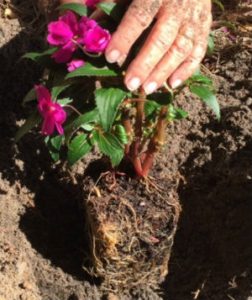Gardeners can greatly enhance the health of their new plants by following recommendations on how to successfully install them. The following guidelines for installing perennials and annuals apply for sandy, well-drained soils, much like we find in Polk County. Follow these suggestions to properly plant your perennials and annual bedding plants.

* Plants should be well-rooted in container; roots should extend just to interior of pot. Generally, it is not necessary to cut into roots of plants in small containers; damage can occur to plant from rough handling of root ball. If plants are pot-bound, cut circling roots. It is best to examine plants prior to purchasing to avoid pot-bound plants!
* When selecting annual plants, if possible, purchase the largest size container of your desired plant. The larger root ball can lend a boost to the predictability of transplanting success.
* If desired, amend sandy soils with organic materials (peat, compost, etc.). Work into soil 10-12 inches. It is best to amend the entire bed, rather than just the planting hole.
*There is no need to amend soil for native wildflowers that occur naturally in sandy soils.
* Dig hole so the height of the root ball is at – or slightly higher – than ground level when plant is installed. (This allows for settling.)

* Dig hole slightly wider than the root ball. (The loosened soil will enhance lateral root development.)
* Hole should have flat-shaped bottom; (avoids air pocket at bottom). Leave soil at bottom as undisturbed as possible (to discourage settling).
* Make sure root balls are well watered in; never plant a dry root ball.
* Place plant in hole. Gently return soil around root ball, using trowel or your hand. Do not stomp on plant or compact soil. Compacting soil reduces oxygen that is necessary for root development.
* Rake surrounding soil smooth and level, to allow for good drainage.
* There is no need to add a ring of soil around perennials or annuals when planting.
* Water and mulch appropriately. Avoid mulch around the center of plants.

* Fertilize as directed. (Most annuals and small perennials have just come from the nursery and already have been recently fertilized. Can add slow-release fertilizer to the top of surrounding soil if desired.)
* Avoid piling up soil around the center of the plant. If the plant seems unstable after installing, it was probably installed too high; best to remove and replant at proper height.
Molly Griner has been a UF/IFAS Extension Polk County Master Gardener since 2003.
For more information, contact UF/IFAS Extension Polk County at (863) 519-1041 or visit us online at http://sfyl.ifas.ufl.edu/polk. The Plant Clinic is open Monday-Friday, 9:00 am-4:00 pm to answer your gardening and landscaping questions. Visit us in person, give us a call, or email us at polkmg@ifas.ufl.edu.
 0
0
